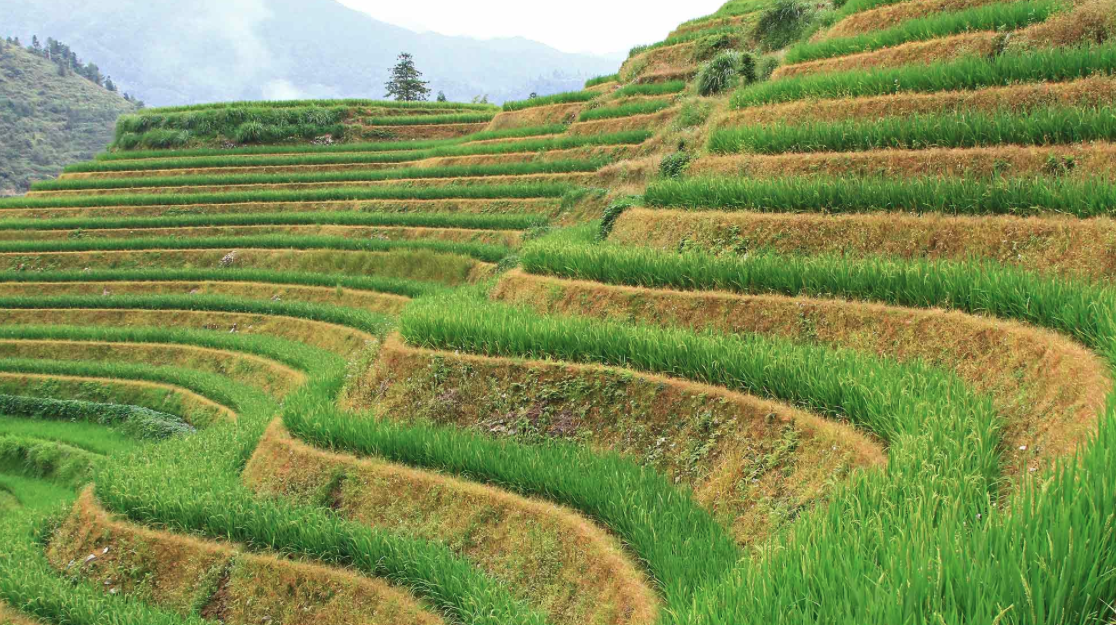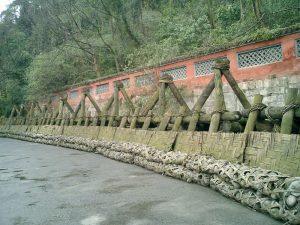
I don’t see farmers growing food on terraces. We don’t have to plant on hillsides, since, something over 300 million of us rattle around in our enormous country. We can leave scrub lands to the deer. But in China, the population count has been biting hard for hundreds of years. So we find extensive use of terracing there. The photo above is of the remarkable Dragon’s Backbone Terrace built by hand 650 years ago to grow rice.
Asian farming practices, such as terracing, are described in by F. H. King in Farmers of Forty Centuries, a book that proves the dullest subject can be a rippin’ good read in the hands of a real storyteller. To say King was wildly enthusiastic about Asian farming would be an understatement. He was a highly regarded soil scientist in the early 1900’s and he strongly believed farmland could be healthy only if nutrients were replenished. He worked for the USDA Bureau of Soils and the head of the Bureau, Milton Whitney, insisted that soil was indefinitely productive and natural processes would maintain soil’s good health without additives. Refusing to be associated with what he believed to be heresy, King resigned and traveled to the East.
I will focus here on King’s writings on China. There, he found farmers who added everything they could get their hands on to keep their soil productive — as they had for 4000 years. They used chaff from harvested grains, cuttings from vegetables and fruits, rotting trees and plants, human excrement, animal excrement, clothing. King watched human waste from Canton and Hong Kong applied in diluted form to a field of leeks at a rate of 16,000 gallons per acre–all carried on the shoulders of workers in pails. Another laborious practice was the exchange of soil between mulberry orchards and rice fields since this increased production of both plants–all done in buckets by hand.
I first encountered the Chinese devotion to their fields in Pearl Buck’s The Good Earth. It is the only movie I have ever seen that was better than the book. I watched 20-year old O-lan bear her first child, strap him to her back and go back to work in her field. There are no words. So many people on so little arable land.
According to King, it was common to see three crops on one field, one ready to harvest, one just up and one in growth. In other areas, fields which had matured two crops of rice were planted with grain, cabbage, peas and beans, producing three or four crops a year. This intensive, continuous cropping can work only by heavy fertilization and irrigation.
China at the turn of the 20th century had at least 200,000 miles of canals for irrigation. The canals also provided fertilizer, the nutrient rich mud was removed from the bottom of the canals and put on fields–at a rate of about 70 tons an acre. I have a creek and a pond, but have never considered using the rich mud to fertilize my pastures. What an undertaking that would be, but King observed that, in China, no labor was too much to keep food on the table. Waste was brought from stables, allowed to percolate in the canals and then dipped out of the canals to fertilize plants. Clover was planted in pits dug three feet deep and when it blossomed, it was cut and stacked, allowed to ferment and then spread on fields. The photo here is of a levee made of sausage-shaped baskets of woven bamboo filled with stones held in place by wooden tripods.
is of a levee made of sausage-shaped baskets of woven bamboo filled with stones held in place by wooden tripods.
King writes, that he walked by a pigpen with a smooth, well-laid stone floor. It had just been washed scrupulously clean, like the floor of a house. “I have little doubt” he says, “that the washings from this floor had been carefully collected and taken to some receptacle to serve as a plant food.”
Of course, now, China uses the practices of Big Agriculture. Most of the ‘civilized’ world shares the practice of drenching our soils with herbicides, pesticides and petroleum based fertilizers. Not that there is anything wrong with a bag of high quality organic fertilizer used in combination with organic matter like manure. Pest controls used thoughtfully are a good idea. The question is the same one raised by King. Can we kill our soil? Do we need to consider aeration, texture and the microbes? Or will it regenerate indefinitely. It’s only dirt.
There is a scene during a famine in The Good Earth when hungry bandits see smoke from O-lan’s chimney. They burst in, see the children at the table, rush to the cooking pot and leave disgusted.What was cooking was dirt.